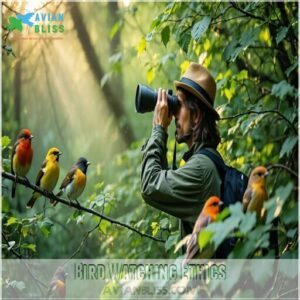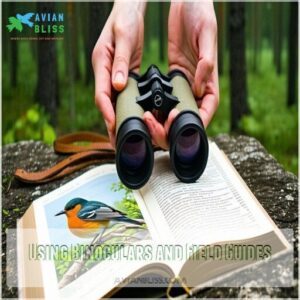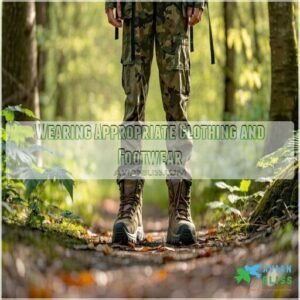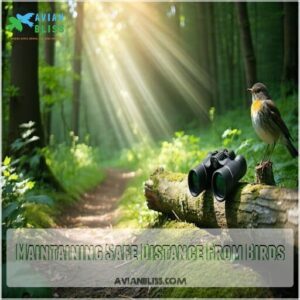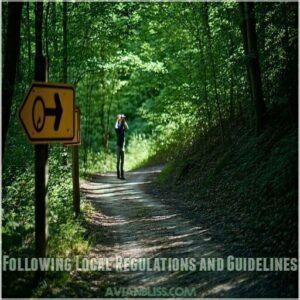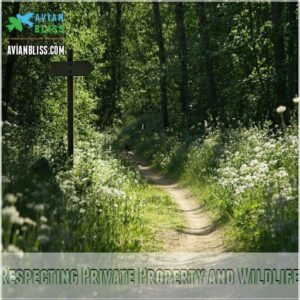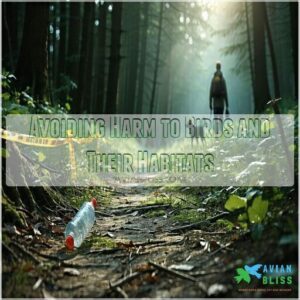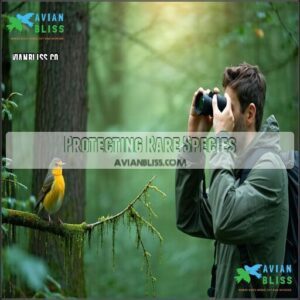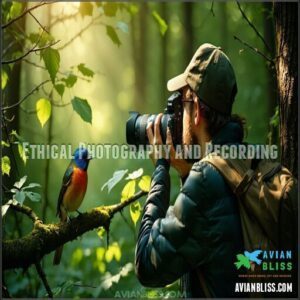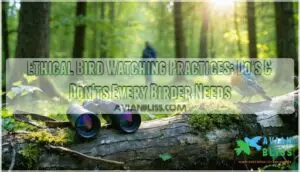This site is supported by our readers. We may earn a commission, at no cost to you, if you purchase through links.
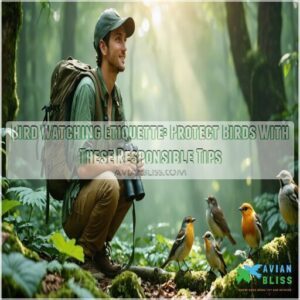
Stick to marked trails to avoid trampling delicate habitats, and never use bait or recorded calls to lure birds in—it stresses them out.
If a bird looks flustered or you hear alarm calls, give them space to breathe (literally), and wear neutral clothing to blend in.
Make sure your footsteps aren’t louder than the birds you’re observing, and respect nature to help keep the skies alive with song for years to come.
Table Of Contents
- Key Takeaways
- Bird Watching Ethics
- Responsible Birding Practices
- Birding Code of Conduct
- Protecting Rare Species
- Ethical Photography and Recording
- Frequently Asked Questions (FAQs)
- What is the code of ethics for bird watching?
- What is the BIRDIST rule 10?
- What is code 5 in birding?
- What is birding etiquette?
- How can I handle insect bites while birding?
- What food and snacks are birding-friendly?
- Are pets ever allowed on birdwatching outings?
- How to stay safe during extreme weather?
- What apps are best for bird identification?
- Conclusion
Key Takeaways
- Keep your distance and use binoculars to observe birds without disturbing their natural behavior.
- Stick to trails, avoid nests, and don’t use bait or recorded calls to respect habitats and wildlife.
- Stay quiet, wear neutral clothing, and watch for signs of stress like alarm calls or sudden movements.
- Follow local guidelines, support conservation efforts, and always leave no trace to protect bird habitats.
Bird Watching Ethics
When you practice ethical birdwatching, you help protect birds, their habitats, and natural behaviors.
It’s all about respecting wildlife by keeping your distance, staying quiet, and following guidelines designed to minimize harm, which is a key part of responsible birdwatching.
Respecting Birds and Habitats
Respecting birds and habitats is at the heart of bird watching etiquette.
Stick to trails, minimize noise, and use silent communication to prevent disrupting natural behaviors.
Nesting sites need extra caution—disturbing them can harm fragile ecosystems.
Ethical baiting is fine sparingly, but always follow local regulations.
Respect wildlife, protect bird habitats, and support bird conservation efforts with mindful practices, ensuring to respect the environment and follow local regulations.
Minimizing Disturbance to Birds
When birdwatching, quiet observation is key to minimize disturbance to birds.
Quiet observation helps you blend into nature, allowing birds to relax as you witness their natural behaviors undisturbed.
Keep noise low and avoid nesting areas to respect wildlife. Watch for stress signals, like sudden movements or alarm calls, and retreat if needed to reduce bird stress.
Ethical baiting and responsible playback should be sparing, preserving habitat preservation. Always prioritize birds’ well-being over the perfect view.
To further protect bird populations, consider following birding ethical guidelines.
Supporting Conservation Efforts
You can make a difference by supporting organizations focused on habitat preservation and bird conservation.
Join citizen science projects to track species, reduce litter during outings, and use ethical bird photography to minimize disturbance to birds.
Never buy trafficked birds or products, and report any suspicious activity to ensure safer environments for birds while protecting their future.
Responsible Birding Practices
When you practice responsible birding, you help protect birds and their habitats while enhancing your experience.
By using the right tools, staying quiet, and keeping a respectful distance, you can observe birds without causing them stress.
Using Binoculars and Field Guides
Get the most out of birdwatching with proper use of binoculars and a field guide.
- Choose binoculars with appropriate magnification for sharp details.
- Verify field guide accuracy, focusing on your region.
- Practice identification techniques to observe subtle bird behavior.
- Maintain equipment regularly for clarity and function.
Stay adaptable; ethical birding safeguards birds at a safe distance. Consider binoculars’ magnification power for ideal viewing to enhance your birdwatching experience with the right magnification.
Wearing Appropriate Clothing and Footwear
While binoculars are handy, what you wear matters too.
Stick to camouflage colors and comfortable layers to blend in.
Quiet footwear avoids alarming birds, while durable fabrics and weather protection keep you cozy.
Think breathable clothes for warm days and waterproof gear for rain.
Birdwatching etiquette starts with dressing smartly—you’re in their home, so be respectful.
Remember to wear neutral colors, as bright clothing can startle birds.
To further improve your experience, consider practicing bird-oriented etiquette.
| Tip | Why It Matters | Example |
|---|---|---|
| Camouflage Colors | Keeps you invisible to birds | Olive, tan, or green gear |
| Quiet Footwear | Reduces noise that scares wildlife | Soft-soled hiking boots |
| Comfortable Layers | Adaptable to shifting weather | Light jacket, wool sweater |
| Durable Fabrics | Withstands outdoor wear and tear | Ripstop materials |
Maintaining Safe Distance From Birds
A colorful shirt might spook a bird, but respecting boundaries keeps them relaxed.
Maintain a safe distance during birdwatching to minimize disturbance birds feel. Watch for avian stress signals to practice birdwatching etiquette effectively.
- Use binoculars for quiet observation.
- Notice Bird Behavior from afar.
- Prioritize habitat preservation by staying on trails.
- Avoid chasing birds.
- Retreat if stress cues intensify.
To ensure a positive experience, it is crucial to follow these guidelines and respect the birds’ boundaries.
Birding Code of Conduct
You play a pivotal role in bird conservation by following a proper birding code of conduct, which guarantees the safety of birds, their habitats, and fellow birders.
Stick to local guidelines, respect private property, and always prioritize minimal disruption to wildlife, ensuring that your actions support the well-being of birds and their ecosystems, which is crucial for bird conservation.
Following Local Regulations and Guidelines
Before heading out with your field guides and binoculars, brush up on local regulations.
Follow permit requirements, honor seasonal closures, and stick to designated trails.
Abide by noise restrictions to keep birds stress-free, and practice proper waste disposal.
Staying informed guarantees bird watching etiquette aligns with bird conservation efforts while keeping you on the right side of legal compliance.
Respecting Private Property and Wildlife
When birdwatching, always respect private property and wildlife.
Seek landowner permission for private land access and follow trail etiquette on public property.
To prevent trespassing, stick to marked paths.
Protect habitats by minimizing noise pollution and adhering to legal compliance.
Remember: Habitat preservation helps birds thrive and guarantees mutual respect between birders, landowners, and nature lovers.
It’s also important to practice responsible birding practices to minimize disturbance, ensuring mutual respect and promoting wildlife conservation through responsible birding.
Avoiding Harm to Birds and Their Habitats
In the context of bird watching etiquette, distance matters more than you think.
Stay on trails to prevent habitat destruction and minimize noise that could stress birds.
Avoid ethical feeding; unnatural food can harm their health.
Don’t forget pet impact—leave furry friends at home.
Limit group size and embrace these bird conservation tips to protect their natural habitats!
Protecting Rare Species
When you’re watching rare birds, your actions matter more than you might think.
By keeping a respectful distance and avoiding their nesting areas, you’ll help protect these vulnerable species.
While enjoying their beauty responsibly is crucial, it is also important to remember that your actions have a significant impact on these species.
Identifying Endangered Species and Their Habitats
Endangered species face challenges like habitat loss and species vulnerability, making identification essential for bird conservation.
Start by:
- Researching legal protections and their conservation status.
- Learning to spot habitat needs through monitoring programs.
- Using field guides to identify rare birds.
- Observing birdwatching etiquette to reduce stress on bird habitats.
Your actions directly support preserving vulnerable species.
Avoiding Disturbance to Nesting and Breeding Activities
When observing birds during breeding seasons, stay attentive to their natural behaviors.
A quiet approach helps prevent stress and keeps nesting sites safe. Maintain a respectful distance to avoid disrupting fragile activities like chick protection or feeding.
If you notice alarm calls or signs of avian stress, retreat promptly.
Respecting nesting sites guarantees birds can thrive without unnecessary disturbance, ensuring their natural behaviors and chick protection are not compromised.
Supporting Conservation Efforts for Rare Species
Protecting rare species starts with habitat preservation and funding conservation groups that tackle complex threats like poaching.
Anti-poaching measures and policy advocacy are essential to safeguard endangered species.
You can also support bird conservation through community involvement, like creating native gardens or joining initiatives.
Birds’ roles include critical seed dispersal, which is indispensable for forest regeneration.
By respecting bird watching etiquette, you’ll help guarantee a future for rare species and their fragile ecosystems, ensuring the continuation of critical conservation efforts.
Ethical Photography and Recording
When photographing or recording birds, use your equipment carefully to avoid disturbing their natural behaviors.
Keep things quiet, skip the flash, and share your work responsibly to protect both birds and their habitats.
Using Camera Equipment Responsibly
Using camera equipment responsibly is a cornerstone of ethical birdwatching. A long lens allows you to maintain proper lens distance, avoiding habitat disturbance.
Flash prohibition guarantees birds aren’t startled, while following audio ethics prevents unnecessary stress. Responsible recordings and data sharing protect sensitive species and their locations.
Selecting the right gear, such as specialized camera bodies, can improve your shots. Ethical photography enhances birdwatching photography, guaranteeing memories are captured without compromising wildlife safety and supporting responsible recordings.
Avoiding Flash Photography and Loud Noises
Loud noises and flash photography harm birds by startling them, disrupting behaviors, and increasing stress.
Silent birding techniques, like whispering and muting devices, reduce noise pollution impact. Avoid flash photography to protect birds’ vision, especially nocturnal species.
Watch for bird stress signals, like sudden movements or alarm calls, and retreat respectfully. Noise-free, natural observation epitomizes birdwatching etiquette, blending respect with meaningful experiences.
Sharing Images and Data Responsibly
While avoiding flash preserves birds’ calm, sharing images demands equal care.
Practice location obfuscation and image alteration by removing GPS data to protect nesting spots. Responsible reporting respects privacy, aligning with conservation ethics.
Highlight conservation impact in captions to inspire others. Birdwatching isn’t just observation—it’s stewardship.
Thoughtful sharing upholds etiquette, safeguarding habitats while fostering appreciation for these feathered marvels.
Some practices, such as call playback’s impact, can distress birds and disrupt natural behaviors, which requires responsible reporting and consideration of privacy.
Frequently Asked Questions (FAQs)
What is the code of ethics for bird watching?
Follow the birdwatching code of ethics by respecting wildlife, avoiding nests, minimizing noise, staying on trails.
Report rare sightings responsibly, protect habitats, and support conservation efforts to safeguard birds’ natural behaviors, keeping a safe distance.
What is the BIRDIST rule 10?
Birdist Rule 10 reminds you to “spread the birding love.”
Share your knowledge, encourage beginners, and foster a welcoming community.
Celebrate diversity, respect all skill levels, and inspire others to cherish and protect birds.
What is code 5 in birding?
In birding, Code 5 refers to extremely rare species that are far outside their normal range.
These sightings often spark excitement in birding communities but demand careful observation to guarantee accurate identification and responsible reporting, which is a critical aspect of the process.
What is birding etiquette?
Birding etiquette means respecting birds and their habitats by keeping a safe distance, staying quiet, and leaving no trace.
It also involves following local rules, sharing knowledge responsibly, and prioritizing conservation to support wildlife, which is a key part of wildlife.
How can I handle insect bites while birding?
Pack insect repellent to ward off bites, focusing on DEET-free options to protect your skin and nature.
Wear long sleeves, tuck pants into socks, and choose light colors.
Bring anti-itch cream—mosquitoes love birdwatchers too!
What food and snacks are birding-friendly?
Fuel your adventure with trail mix, granola bars, or dried fruit—they’re portable and bird-friendly without wrappers flying away.
Sip water, not sugary drinks, to stay hydrated, and avoid crumbs that might attract unwanted predators, focusing on portable options.
Are pets ever allowed on birdwatching outings?
Pets usually aren’t welcome on birdwatching outings.
Even the best-behaved dog can scare birds with movement or scent.
If you must include your pet, make certain it’s leashed, quiet, and only in pet-friendly locations.
How to stay safe during extreme weather?
Like a sturdy umbrella in a sudden storm, prioritize waterproof gear, layer clothing, and pack essentials like water, snacks, and a first-aid kit.
Avoid open areas during lightning, and always monitor changing conditions.
What apps are best for bird identification?
You’ll love apps like Merlin Bird ID for photo or sound-based identification, eBird to log sightings, and Audubon Bird Guide for field expertise.
They simplify birdwatching, making the skies your interactive avian adventure!
Conclusion
Bird watching etiquette for protecting birds isn’t just a suggestion—it’s the lifeline for their survival and your experience.
By keeping your distance, staying on trails, and blending in with neutral clothing, you reduce stress on wildlife while enjoying them in their natural habitat.
Avoid bait or recorded calls, and always respect nesting sites.
Every small action—quiet steps, responsible photography, or conservation support—adds up.
Protect birds today to guarantee their melodies echo tomorrow. It’s simple, impactful, and rewarding.
- https://www.birds.cornell.edu/landtrust/aba-code-of-birding-ethics/
- https://www.bird.bot/post/birding-ethics-responsible-birdwatching-practices-to-protect-our-feathered-friends
- https://www.ontarioparks.ca/parksblog/ethical-birding/
- https://www.aba.org/aba-code-of-birding-ethics/
- https://www.undp.org/belarus/stories/artificial-nesting-way-care-birds

